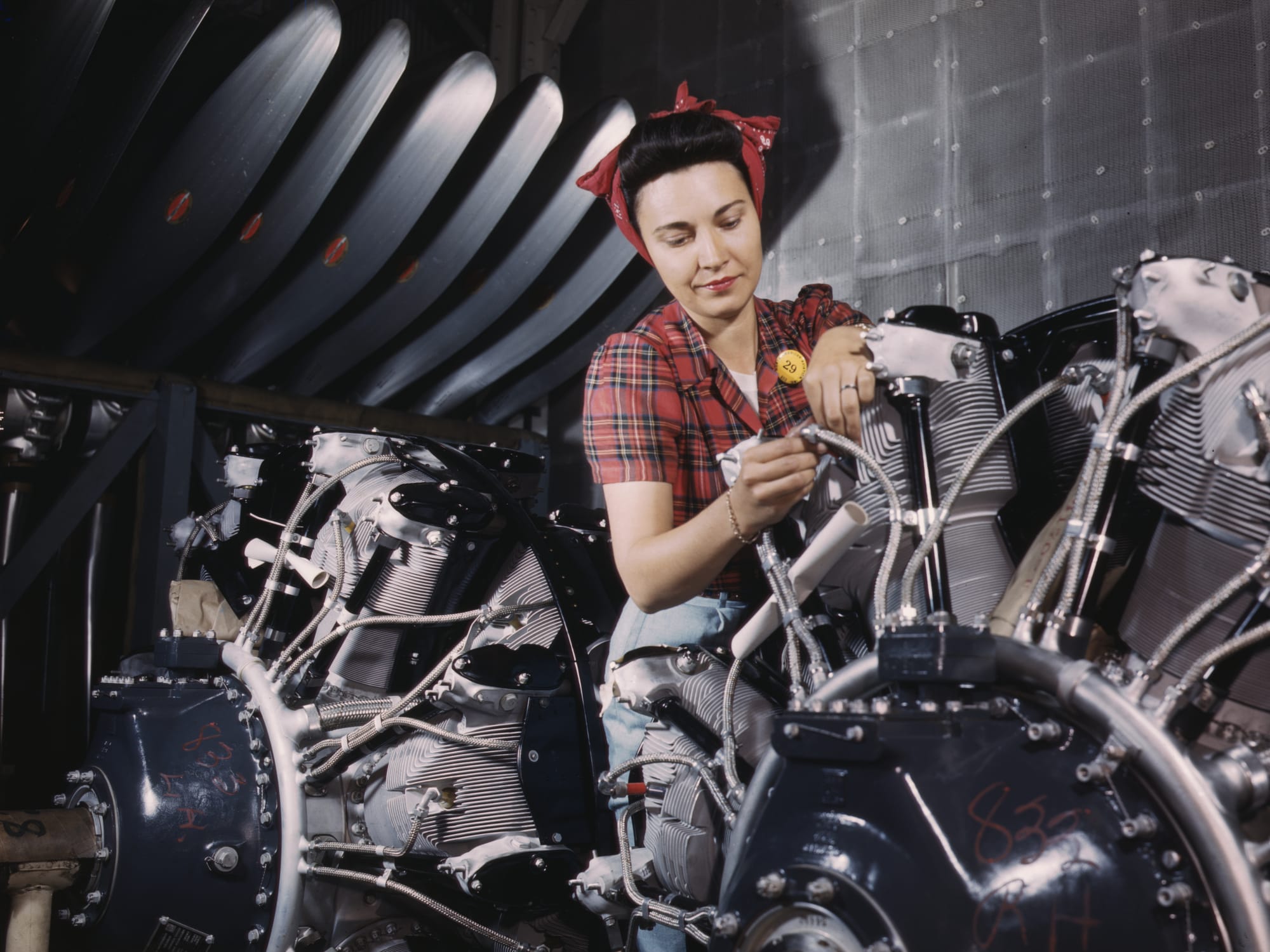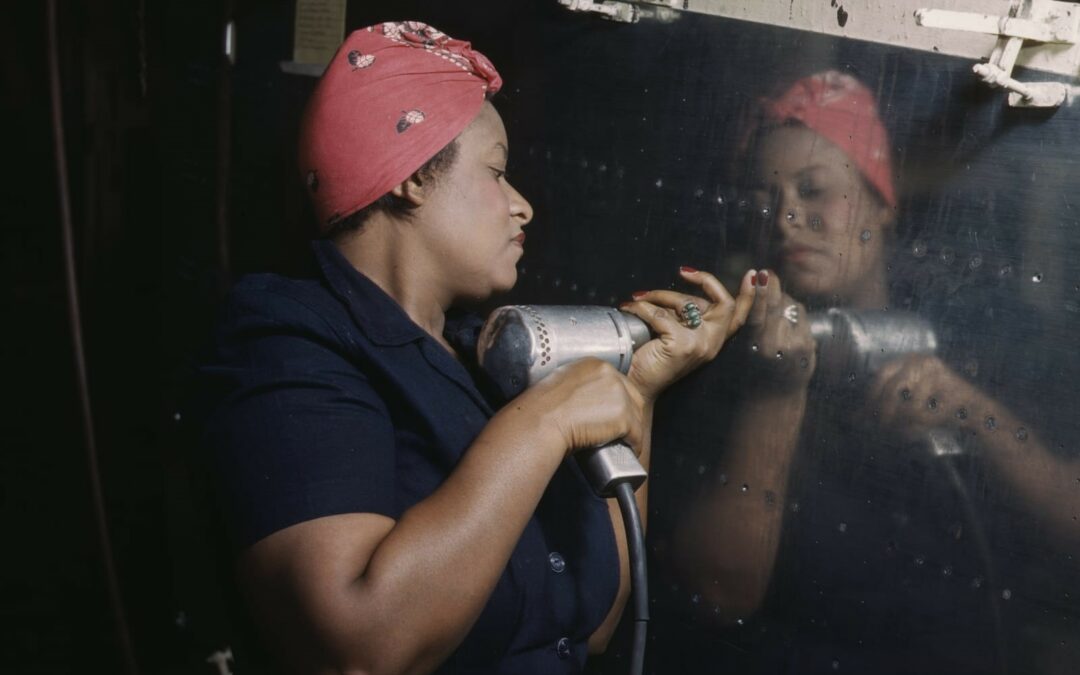In the image above, a woman operates a hand drill while working on a “Vengeance” dive bomber in Nashville, Tennessee, 1943. Library of Congress.
For many of us, thinking of women in skilled trades still brings to mind the iconic 1940s posters of “Rosie the Riveter” or black and white pictures of women in coveralls and welding goggles. In a recent Talent Shortage Survey, ManpowerGroup noted that the current skills gap marks the biggest shift and reallocation of skills since WWII began. Many of our current difficulties in finding skilled workers mirrors what manufacturers faced in the 1940s—skills in high demand and a shortage of workers who traditionally filled those positions. Our way forward may be similar to what it was then: hire and train the available workforce to do the job.
In 1941, that meant millions of women learning how to service bombers and build battleships. Now, we need workers for high-tech automation and robotics positions in manufacturing and logistics. We can improve our current skills gap by shedding more light on how modern women enter the skilled trades and the positive impact they (and other traditionally “non-skilled” populations) can have on the skilled worker shortage.
Historical Perspective
An estimated six million women joined the civilian workforce during WWII. They filled traditionally male roles in transportation, construction, manufacturing, agriculture, and more. Between 1940 and 1945, the female percentage of the workforce increased from 27% to 37%, and by 1945 one in every four married women worked outside the home.
In some industries, women soon made up the majority of workers and 3.8 million women entered manufacturing alone. By 1943, 310,000 women worked in the U.S. aircraft industry, making up 65% of the industry’s total workforce (compared to 1% in pre-war years).

In the image above, a woman works on an airplane motor at the North American Aviation, Inc, plant in Inglewood, California, 1942. Library of Congress.
Now, even though women make up half of the U.S. workforce, they are still underrepresented in most skilled trades like construction and manufacturing.
What Does This Mean for Employers Navigating Skills Gaps?
Although more women are pursuing careers in skilled trades, the current skills gap is calling for more creative (and drastic) solutions. There is still plenty of work to be done and not enough skilled workers to go around. Here are four actionable things employers can do to build competent workforces and create more opportunities for women (and others!) to enter the skilled trades.
1. Understand Skills Gap Complexity
The skills gap is not a simple “shortage of workers.” It is a complex issue with a host of contributing factors including (but not limited to) a retiring workforce, new technology, and evolving job roles. Deloitte predicts 4.6 million manufacturing jobs will be created over the next decade and 2.4 million of those positions will likely remain unfilled.
Skilled workers now need a much broader portfolio of skills to keep pace with technological change. Employers should familiarize themselves with the essential skills in their industry and how those skills are likely to change as technology advances. Conducting a skills gap analysis will also help identify critical skills and create a plan to equip workers with those skills.
2. Combat Negative Industry Perceptions
Despite exciting new advances and near-constant innovations, a surprising number of Americans still have negative misconceptions about the skilled trades. Whether it’s thinking that robots are taking jobs away from humans or assuming all manufacturing takes place in grimy, poorly lit factories, these assumptions may turn people away from what are actually rewarding, well-paying careers.
Employers should educate their communities about the possibilities in their industries, the potential for professional development, and the different career paths available.
3. Connect with Local Community
Employers must also consider partnering with local schools and workforce development programs. If you identified a list of skills or industry certifications through your skills gap analysis, share that information with local programs so they can offer relevant training to learners. This benefits the community by equipping new workers with relevant skills and helps the employer create a pool of skilled applicants.
One of Nocti Business Solutions’ industry partners, the Manufacturing Skill Standards Council (MSSC), offers certification programs for skilled technicians in manufacturing and logistics. MSSC has worked to make its certifications accessible to a wide range of job seekers, including women, active-duty military, incarcerated people, those with low-paying jobs, and those who do not have time or resources for a two or four-year degree.
4. Build a Talent Pipeline
A skilled, competent workforce is critical for your future growth. Building a talent pipeline ensures you will be able to hire skilled workers now and in the future—even if skills continue to change and evolve.
Upskill incumbent workers to fill the most critical skills gaps. Upskilling is especially useful for industries implementing automation or undergoing a digital transformation. This kind of on-the-job training is also important to potential employees. A study by Sitel Group found that 80% of people consider a formal training program an important factor when looking to change employers. 88% of GenZ said it was important for their future employer to offer an upskilling program.
Apprenticeship programs combine technical classroom instruction with on-the-job training. Creating your own apprenticeship program will be a long-term source of skilled workers since 94% of apprentices stay with their employers after completing their programs. Apprenticeship Works! and the JFF’s Center for National Apprenticeship & Work-Based Learning can help you get started.
Skills assessments can make your recruiting process effective by accurately identifying candidates’ skills and predicting future job performance. Skills assessments can also help objectively narrow down a list of candidates, eliminate bias, and create a more legally defensible hiring process.
Build a Skilled Workforce with NBS
Nocti Business Solutions is dedicated to helping companies of all sizes build competent workforces. However, the ongoing skills gap calls for creative solutions. We must all do our part to make skilled positions more accessible to women and to anyone who wishes to pursue a skilled trades career.

Recent Comments